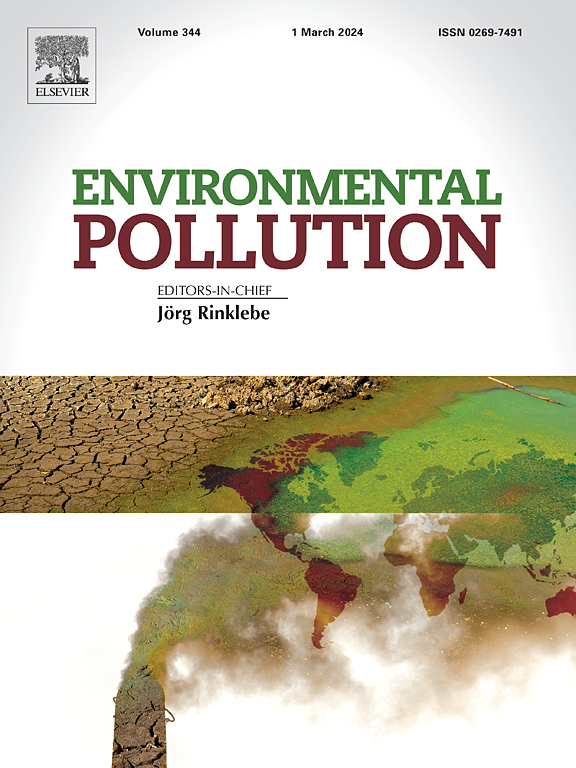Microplastics in the Euphrates: Assessing contamination in water, sediment, and commercial fish species
IF 7.6
2区 环境科学与生态学
Q1 ENVIRONMENTAL SCIENCES
引用次数: 0
Abstract
Microplastics (MPs) are increasingly recognized as emerging pollutants in freshwater ecosystems, with implications for ecological integrity and food safety. This study presents the first integrated assessment of MP contamination in the Euphrates River (Türkiye), focusing on water, sediment, and six commercially important fish species. We hypothesized that MP abundance in fish would vary according to species-specific feeding behavior and habitat use. To test this, sampling was conducted at 23 sites encompassing urban, agricultural, and industrial zones. MPs were identified and quantified using stereomicroscopy and Fourier-transform infrared spectroscopy. MPs were detected in 52.2 % of water samples (0–6.6 MP/m3) and 43.5 % of sediment samples (0–15 MP/kg), with fibers and polyethylene terephthalate were the dominant forms. Among fish species (Capoeta trutta, Carasobarbus luteus, Cyprinus carpio, Cyprinion macrostomus, Chondrostoma regium, and Carassius gibelio), MP abundance ranged from 0.2 to 1.76 MPs/individual. Contrary to our initial hypothesis, MP loads did not significantly differ among species or locations. Moreover, statistical analyses revealed no significant associations between MP ingestion and fish traits such as age, length, or weight. However, relatively high MP levels were observed in C. trutta, possibly reflecting its benthopelagic habitat and omnivorous diet. These findings point to a diffuse and widespread pattern of MP contamination, likely driven by multiple anthropogenic sources and hydrodynamic factors. The study underscores the need for targeted pollution control strategies and highlights the ecological vulnerability of the Euphrates River.


幼发拉底河中的微塑料:评估水、沉积物和商业鱼类的污染
微塑料(MPs)越来越被认为是淡水生态系统中的新污染物,对生态完整性和食品安全具有影响。本研究首次对幼发拉底河(t rkiye)的MP污染进行了综合评估,重点关注水、沉积物和六种重要的商业鱼类。我们假设鱼类的MP丰度会根据物种特定的摄食行为和栖息地使用而变化。为了验证这一点,在包括城市、农业和工业区在内的23个地点进行了抽样。利用体视显微镜和傅里叶变换红外光谱对MPs进行鉴定和定量。52.2%的水样(0-6.6 MPs/m3)和43.5%的沉积物样品(0-15 MPs/kg)中检测到MPs,其中纤维和聚对苯二甲酸乙二醇酯为主要形式。鱼类(卡波塔(Capoeta trutta)、黄斑鱼(Carasobarbus luteus)、鲤鱼(Cyprinus carpio)、大口鲤(Cyprinion macrostomus)、大区软骨瘤(Chondrostoma regium)和异种鲫鱼(Carassius gibelio))的MP丰度在0.2 ~ 1.76 MPs/只之间。与我们最初的假设相反,MP负荷在物种或地点之间没有显着差异。此外,统计分析显示,MP摄入与鱼的年龄、长度或体重等特征之间没有显著关联。然而,在C. trutta中观察到相对较高的MP水平,可能反映了其底栖栖息地和杂食性饮食。这些发现表明,MP污染是一种扩散和广泛的模式,可能是由多种人为来源和水动力因素驱动的。该研究强调了有针对性的污染控制策略的必要性,并强调了幼发拉底河的生态脆弱性。
本文章由计算机程序翻译,如有差异,请以英文原文为准。
求助全文
约1分钟内获得全文
求助全文
来源期刊

Environmental Pollution
环境科学-环境科学
CiteScore
16.00
自引率
6.70%
发文量
2082
审稿时长
2.9 months
期刊介绍:
Environmental Pollution is an international peer-reviewed journal that publishes high-quality research papers and review articles covering all aspects of environmental pollution and its impacts on ecosystems and human health.
Subject areas include, but are not limited to:
• Sources and occurrences of pollutants that are clearly defined and measured in environmental compartments, food and food-related items, and human bodies;
• Interlinks between contaminant exposure and biological, ecological, and human health effects, including those of climate change;
• Contaminants of emerging concerns (including but not limited to antibiotic resistant microorganisms or genes, microplastics/nanoplastics, electronic wastes, light, and noise) and/or their biological, ecological, or human health effects;
• Laboratory and field studies on the remediation/mitigation of environmental pollution via new techniques and with clear links to biological, ecological, or human health effects;
• Modeling of pollution processes, patterns, or trends that is of clear environmental and/or human health interest;
• New techniques that measure and examine environmental occurrences, transport, behavior, and effects of pollutants within the environment or the laboratory, provided that they can be clearly used to address problems within regional or global environmental compartments.
 求助内容:
求助内容: 应助结果提醒方式:
应助结果提醒方式:


